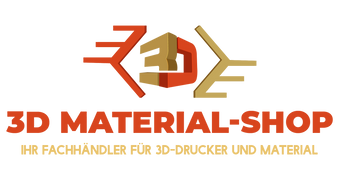Extruders are one of the most important components of an FFF or FDM printer, so we dedicate a separate blog post to this topic.
The extruder fulfills the task of a conveyor and presses a certain amount of filament at high temperatures through the so-called hotend, which consists of a nozzle, a heat block with a temperature sensor and heat cartridge, a tapered transition piece which acts as a heat brake and a heat sink with a fan. The so-called cold end provides the feed. This consists of a stepper motor, a small gear wheel and a pressure roller.
types of extruders
There are many different types of extruders, which differ in detail. A distinction is made between single and dual extruders on the one hand and between direct and Bowden extruders on the other. There are now even so-called pellet extruders. Plastic pellets are used directly for the extrusion without the intermediate step of making wound threads out of them. If this technology catches on, it can help to reduce production costs in the future.
Single and dual extruders
In the case of the dual extruder, this has the advantage over the single extruder that you can print two filaments at the same time. This means that different colors but also different materials are conceivable. A prominent application of the dual extruder is the use of carrier materials such as water-soluble PVA, HIPS, etc. This enables the construction of complex geometries and geometries with overhangs.
IDEX dual extruder
A special design is the IDEX technology from BCN3D and Raise3D, which works in parallel with two independently operating print heads. This allows two components to be printed at the same time or two mirrored components.
Bowden extruder
With the Bowden extruder, the stepper motor is attached to the frame or printer housing and is connected separately to the printer head (hot end) with a hose.
direct extruder
With the direct extruder, the stepper motor is connected directly to the printer head. Small gears are built into the stepper motors that pull the filament from the spool. The filament is moved back and forth in precise steps.
To make it easier for you to decide whether you should choose a direct or Bowden extruder, we will present the advantages and disadvantages of both systems.
With the direct extruder, the shortened feed path from the feeder to the print head enables better and more even extrusion. In addition, a faster retraction is guaranteed, ie the direct extruder can retract the filament faster. A lower torque is already sufficient to feed the filament through the hotend. Another advantage is the wider filament selection. Rough and abrasive materials are easier to process.
With the direct extruder, the feeder (filament feeder) is located directly on the print head, which causes additional weight on the axes. This can result in a slowdown in print speed, jitteriness due to vibration, and associated slight loss of accuracy and precision.
In contrast, printing with the Bowden extruder is faster and more precise because there is sufficient distance between the feeder and the print head. This means that the weight acting on the axles is minimal. Another advantage of the Bowden extruder is that the more compact design of the print head carriage allows for a larger installation space.
However, the Bowden extruder also requires a stronger motor (electric), since the longer Bowden cable tube, usually made of PTFE, causes more friction between the tube wall and the filament, which must be compensated for. More friction in the tube also means the Bowden extruder needs more time and faster retraction. Since there is a longer conveying path between the extruder and hotend, flexible filaments, for example, are more difficult to process.
Conclusion:
Whichever of the two types of extruder you choose, both systems offer their advantages and, ultimately, good printing results are achieved with both variants. If you like to print with a variety of filament types, such as flexible or abrasive filaments, the direct extruder is preferable. If you prefer fast and precise model creation with the basic types of filament, then the Bowden extruder is the tool of choice.


![Polymaker PolyTerra PLA Dual 1,75mm 1kg - [3D Material-Shop]](http://3dmaterial-shop.de/cdn/shop/files/PolyTerra-Dual-PLA_1-75mm_1kg_Foggy-Purple-Purple_600x600_d536672b-71f5-4400-a9af-a045bd9a226d.jpg?v=1700312155&width=176)